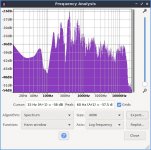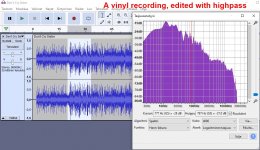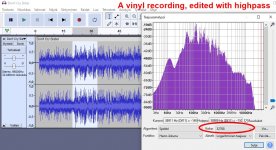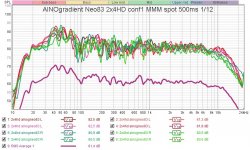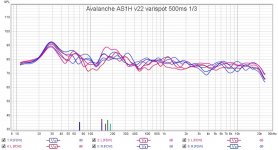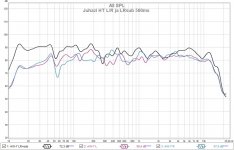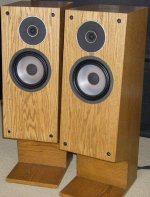I have a thread, where (almost) all of what I've done or experienced (the good and bad) is documented, but it has become impossibly long...
A much more condensed thread can be found here... I even started to document it on a website, but that ain't half finished (I'd rather listen to music 😉).
It does cover most of the tools used but I intended to make it a source for all the crazy things I've tried over the years. Plus sharing the parts I've learned.
I use a lot of DSP and even trickery based on science (like in that thread you mentioned). Most stories I've read of people that start out using DSP is that it makes their speakers sound dull or some other disappointment. I'll tell you, it isn't straight forward right away and it requires patience and perseverance to get the most out of it. But the rewards can be great.
I use a normal functional living room, with limited space available for speakers. The puzzle was to get the most out of that. It made me work that much harder.
Above the Schroeder frequency I want the speaker to be as independent from the room as possible. Below it, I want them to work with the room.
Nowadays the arrays are filtered, consisting of 5 separate driver groups, the higher in frequency one goes, the less speakers contribute. At the bottom end they all share the load.
Don't know what to call them though, 5 way? Or 1.25 way... anyway, if you follow the craze on ASR about the Harman type graphs, you probably wouldn't expect an array like I showed to look like this:

A smooth and slowly rising DI, in other words: predictable results in-room. To take that a step further I put big absorption panels at first reflection points.
Without room treatment and DSP I would never be able to pull all of this off. Going by what I've learned, most of it on this forum and helped and/or inspired by fellow members here...
A much more condensed thread can be found here... I even started to document it on a website, but that ain't half finished (I'd rather listen to music 😉).
It does cover most of the tools used but I intended to make it a source for all the crazy things I've tried over the years. Plus sharing the parts I've learned.
I use a lot of DSP and even trickery based on science (like in that thread you mentioned). Most stories I've read of people that start out using DSP is that it makes their speakers sound dull or some other disappointment. I'll tell you, it isn't straight forward right away and it requires patience and perseverance to get the most out of it. But the rewards can be great.
I use a normal functional living room, with limited space available for speakers. The puzzle was to get the most out of that. It made me work that much harder.
Above the Schroeder frequency I want the speaker to be as independent from the room as possible. Below it, I want them to work with the room.
Nowadays the arrays are filtered, consisting of 5 separate driver groups, the higher in frequency one goes, the less speakers contribute. At the bottom end they all share the load.
Don't know what to call them though, 5 way? Or 1.25 way... anyway, if you follow the craze on ASR about the Harman type graphs, you probably wouldn't expect an array like I showed to look like this:
A smooth and slowly rising DI, in other words: predictable results in-room. To take that a step further I put big absorption panels at first reflection points.
Without room treatment and DSP I would never be able to pull all of this off. Going by what I've learned, most of it on this forum and helped and/or inspired by fellow members here...
Men, after all this, i hope your system sound awesome.I have a thread, where (almost) all of what I've done or experienced (the good and bad) is documented, but it has become impossibly long...
A much more condensed thread can be found here... I even started to document it on a website, but that ain't half finished (I'd rather listen to music 😉).
It does cover most of the tools used but I intended to make it a source for all the crazy things I've tried over the years. Plus sharing the parts I've learned.
I use a lot of DSP and even trickery based on science (like in that thread you mentioned). Most stories I've read of people that start out using DSP is that it makes their speakers sound dull or some other disappointment. I'll tell you, it isn't straight forward right away and it requires patience and perseverance to get the most out of it. But the rewards can be great.
I use a normal functional living room, with limited space available for speakers. The puzzle was to get the most out of that. It made me work that much harder.
Above the Schroeder frequency I want the speaker to be as independent from the room as possible. Below it, I want them to work with the room.
Nowadays the arrays are filtered, consisting of 5 separate driver groups, the higher in frequency one goes, the less speakers contribute. At the bottom end they all share the load.
Don't know what to call them though, 5 way? Or 1.25 way... anyway, if you follow the craze on ASR about the Harman type graphs, you probably wouldn't expect an array like I showed to look like this:
View attachment 1107324
A smooth and slowly rising DI, in other words: predictable results in-room. To take that a step further I put big absorption panels at first reflection points.
Without room treatment and DSP I would never be able to pull all of this off. Going by what I've learned, most of it on this forum and helped and/or inspired by fellow members here...
youve had that system for a long time, iirc almost 10 years. is there a new project in the plans for you?
Nope, it is build to last, just swapped drivers to 50x Scan Speak 10F 8414 G10 and I've been making incremental upgrades/updates each and every year.
Yes, I do think it sounds awesome, now more than ever. Does that mean I'm finished? Never! 😀
The recipe? Change one thing at a time...
Disclaimer:
Is it the best system? Probably not, but it's mine, build by me and it satisfies my wants/needs. It's My-Fi. Is it the best use of the very limited space I have available? Quite possibly so.
Yes, I do think it sounds awesome, now more than ever. Does that mean I'm finished? Never! 😀
The recipe? Change one thing at a time...
Disclaimer:
Is it the best system? Probably not, but it's mine, build by me and it satisfies my wants/needs. It's My-Fi. Is it the best use of the very limited space I have available? Quite possibly so.
Last edited:
80$ a pop?!Nope, it is build to last, just swapped drivers to 50x Scan Speak 10F 8414 G10 and I've been making incremental upgrades/updates each and every year.
Yes, I do think it sounds awesome, now more than ever. Does that mean I'm finished? Never! 😀
The recipe? Change one thing at a time...
Here is frequency response of SP2(2004)speaker in post # 2, a 15" kevlar cone + 1.4" compression driver. Harmonic distortion plot at 1% rated power (5 w) and 10% (50 w). Summary, HD 25 db down from response where I listen to it, 1/8 to 50 w. Bass to 54 hz as tested, and by backing it into a 1" thick 14' long plaster wall, in a heavily damped room, I get about bass ~10 db down at 25 hz. Who needs a sub?Probably offtopic.
can anyone post links to few 2 way speakers (Diy or commercial) with good measurements like linearity, compression*, distortion and low fq. extension in more or less that order of importance ? No subjective review only measurements links.
Attachments
thanks gentlemen.
regards.
That has happened to me couple of times. most recent a LM1875 amp driving indian brand make 3 way hugh vintage speakers. I thought may be it was room or not enough chipamp power. (or may be both) speakers were placed in middle of room with plenty of space in front and back and walls on side in ~140sq.ft. size room.I heard a decent 3 way in a friend's home, but those were gutless wonders, ie no bass.
by engineered you mean listening on axis ? or crossover/dsp ? most recent kit of 2 way with big woofer is Seas A26 and I always wondered how dispersion is managed ?Despite all the fear of beaming posted here a 15" can be engineered to cover 54-1200 hz with minus 3 db point of +-22.2 deg
regards.
The 1508-kadt woofer in the SP2-XT covered +-22.5 deg off axis with 3 db down, 500 hz to 16 khz. 6 db down +-85 deg off axis 500 to 16 k. Crossover @ 1200 hz. See the Peavey datasheet. Woofer is off center in the box.by engineered you mean listening on axis ? or crossover/dsp ? most recent kit of 2 way with big woofer is Seas A26 and I always wondered how dispersion is managed ?
regards.
The same woofer covers 90 deg horizontal 40 deg vertical 6 db down, SP2(2004). Crossover 1800 hz. Woofer is centered but box is trapezoidal, narrower at rear. Through the vent I can see folds of elastomer sheet diagonally.
Pispeakers has a 15" model fourpi or 4symbol. They publish level off axis charts, which look good.
The speakers hiten heard in the center of the room, that is the worst position for bass. Reason moderators on here are always bleating about BSC, baffle step correction in the crossover. Big boost to bass for that location. Homeowners don't need to install speakers in that location. against a hard wall gives 3 db bass boost and in a corner gives 6 db.
Last edited:
Last edited:
And to open a different can of worms there are those who say even an excellent 3-Way is a compromise
^^for sure, trying to minimize issues like modes inside box, diffraction, height and other things one rather quickly gets to a 3-way main speakers and then to ease the room issues, modes, perhaps separate bass system just for that so a four way system.
YepBest 3way is 4way...
Or 3-way with a DSP powered subwoofer.
Still working on the DSP part.
haha yeah it does!It does go down when buying in multiples... 😉
was the upgrade worth it?
i forgot what were the initial drivers used?
To me it was, a slight boost in sensitivity, while lowering the distortion figures... plus it solved an aging problem I had with the previous drivers.

I switched from the Vifa/Peerless TC9 FD18-08 to the Scan Speak 10F 8414G10... They are closely related though. They share a lot of engineering as Scan Speak had developed the TC9 FD18-08 and it's sister driver the TG9 FD10-08 to put out under the Vifa name they used to own. When the Vifa/Peerless branch was sold to Tymphany, Scan Speak developed an improved version they named the 10F. That made this upgrade almost painless, as all holes etc. are in the exact same spot. Only tiny differences in dimensions on the frame. I just had to cut the frame a little to make them fit 🙂.

I switched from the Vifa/Peerless TC9 FD18-08 to the Scan Speak 10F 8414G10... They are closely related though. They share a lot of engineering as Scan Speak had developed the TC9 FD18-08 and it's sister driver the TG9 FD10-08 to put out under the Vifa name they used to own. When the Vifa/Peerless branch was sold to Tymphany, Scan Speak developed an improved version they named the 10F. That made this upgrade almost painless, as all holes etc. are in the exact same spot. Only tiny differences in dimensions on the frame. I just had to cut the frame a little to make them fit 🙂.
Still, an impressive amount of work you did to change out those drivers.Only tiny differences in dimensions on the frame. I just had to cut the frame a little to make them fit
Listen to these and you won't need a bigger woofer.The first thing when you decide to use a dome tweeter, you set a crossover frequency and find you can't use a woofer larger than 6.5", preferrably smaller.
Attachments
Details and links please.Listen to these and you won't need a bigger woofer.
thanks.
Those speakers are Canadian made Energy 22 Reference Connoisseurs. No longer made. There is another similar, the 22 pro model. However the tweeters, which were designed by Winslow Burhoe of EPI fame are fragile. That said the bass that comes out of these is stunning for their size with a 7" woofer. the Canadian national broadcaster,CBC,used these as reference speakers for years.You can look up more details online if you want.Details and links please.
thanks.
- Home
- Loudspeakers
- Multi-Way
- There are great sounding and not super expensive 2-way designs. Why go for 3-way, then?
